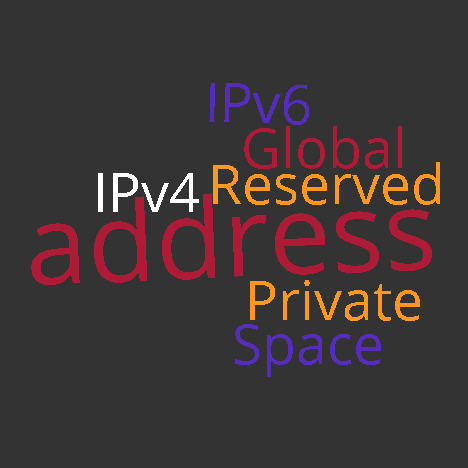The IPv4 and IPv6 address space can be divided to a different address types and sub-types. In this article we will try to elaborate about the different types that are most commonly used
The Internet Assigned Numbers Authority known as IANA reserved some of the prefixes for special use. For example all the private addresses ranges used by most of the home internet users in their LAN are reserved addresses. See example of common reserved address types:
| IPv4 CIDR | IPv6 CIDR | Description |
|---|---|---|
| 0.0.0.0/8 | Used for Broadcast in a segment | |
| 10.0.0.0/8 | fc00::/7 | Used as Private address |
| 127.0.0.0/8 | ::1/128 | Used for loopback address (localhost) |
| 169.254.0.0/16 | fe80::/10 | Used as locallink address see more below |
| 192.0.2.0/24 | 2001:db8::/32 | Used for documentation |
| 224.0.0.0/4 | ff00::/8 | Used for Global multicast |
| 255.255.255.255/32 | Used for Broadcast |
The reserved IP addresses should not be used on the public Internet. Most of the Internet service providers will drop packets and routes that use reserved addressers (also known as Martian networks).
As mentioned above, the private addresses are part of the reserved space and used in most LAN networks. There are three different subnets in the IPv4 space that were defined by RFC1918 and one IPv6 prefix that was defined by RFC4193.
| CIDR | Description |
|---|---|
| 10.0.0.0/8 | Used as Class A Private address |
| 172.16.0.0/12 | Used as Class B Private address |
| 192.168.0.0/16 | Used as Class C Private address |
| fc00::/7 | Used as IPv6 private address - unique local address (ALU) |
Usually LAN network with private address use Network Address Translation defined by RFC1631 to route traffic to the global internet.

Link local address usually used by devices to auto configure their own IP address without the help of other network mechanism like DHCP. IPv4 link local addresses were defined by RFC3927, IPv6 link local addresses are mandatory and were defined by RFC4291.
| CIDR | Description |
|---|---|
| 169.254.0.0/16 | IPv4 link local address, know in Microsoft systems as APIPA |
| fe80::/10 | Unlike IPv4,In IPv6 the link local address are widely used |
The Global or public IP addresses are unique addresses that used by all devices that are connected to the Internet. There are five Regional Internet Registry (RIR):AFRINIC for Africa Region ,APNIC for Asia / Pacific Region ,ARIN for Canada, USA, and some Caribbean Islands, LACNIC for Latin America and some Caribbean Islands, and RIPE for Europe, the Middle East, and Central Asia.Every RIR as diffrent IP ranges and he provides the addresses to local Internet registry (LIR) that provides addresses to entities called Autonomous Systems (AS) that use them to connect to the Internet. For example all of the ISPs are Autonomous Systems and have AS number that idetify them, most of the ISPs are also LIR and provide to there customers IP addresses. In the next section we will explain about the different address types that an ISP can provide.
Provider Aggregatable (PA) are addresses that were allocated by the ISP to the end user. Usually the ISP allocates a prefix from a larger subnet, for example the ISP has the subnet 192.0.2.0/24 and it allocates to the end user the prefix 192.0.2.48/28. The ISP will aggregate all the PA address and advertise via BGP only the subnet 192.0.2.0/24
Provider Independent (PI) are addresses allocated by the RIR to the end user via the LIR as proxy (the ISP can also act as LIR). There are two significant advantages to PI addresses: The end user (AS) can advertise the prefix via BGP to two or more upstream ISPs (Multihomed) for load balancing and high availability. Another advantage is the ability to switch service providers without the need to change the IP Addresses.
Addresses that were allocated until 1995 by the central Internet Registry (IR) directly, and not via the Regional Internet Registries (RIRs). Unlike PI and PA addresses, legacy addresses owners have property rights on them and they can be sold and transferred between companies.